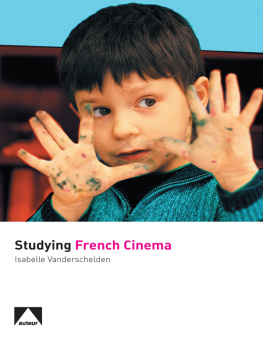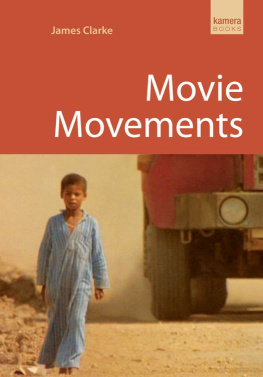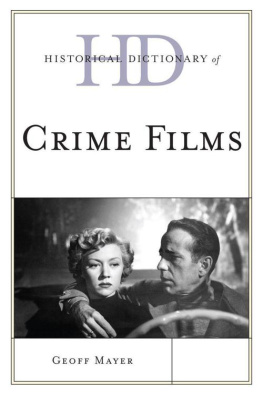STUDYING FRENCH CINEMA
STUDYING FRENCH CINEMA
BY
ISABELLE VANDERSCHELDEN
ACKNOWLEDGEMENTS
I would like to thank the editor of the series, John Atkinson, for his help and patience during the production of this book. I am grateful to Cornerhouse in Manchester for letting me test out some of the films with their audiences in different courses, introductions and Q&As. I would also like to thank Hedy Bush, Margaret Cunliffe, Gordon Eccleston, Mary Hartley, Jackie Johnson, Christine Jones, Joe McGonagle, Valrie Orpen, Elaine Pullin and Darren Waldron for their comments on the various chapters of this book. Special thanks go to Geoff Medland who provided invaluable support and advice at different stages of writing and proofreading. I would also like to thank for their advice on relevant films suitable to use on A Level French programmes the many enthusiastic French teachers who, over the years, have attended some of my film sessions. Finally, thanks to my students at Manchester Metropolitan University who engaged in discussions on the films in their presentations and essays that inspired me to write about them.
AUTHORS NOTE
All translations from French sources provided for the readers reference throughout the book are mine unless otherwise indicated. Film years are year of release unless otherwise indicated. When no page number is provided for a reference it means that this information was not available at the Bibliothque du film in Paris (BIFI) database or that the article was found on the internet site of the newspaper or magazine and no page number was provided. Similarly, some useful website do not provide any date of posting, hence the imprecise referencing. The Box-office statistics were provided by the CNC, the IMDb or the Allocin websites.
First published in 2013 by
Auteur
24 Hartwell Crescent, Leighton Buzzard LU7 1NP
www.auteur.co.uk
Copyright Auteur Publishing 2013
Designed and set by Nikki Hamlett at Cassels Design
Printed and bound by Short Run Press Ltd, Exeter, UK
Cover: tre et avoir (To Be and To Have) BFI Stills
All rights reserved. No part of this publication may be reproduced in any material form (including photocopying or storing in any medium by electronic means and whether or not transiently or incidentally to some other use of this publication) without the permission of the copyright owner.
E-ISBN 978-1-906-73391-9
British Library Cataloguing-in-Publication Data
A catalogue record for this book is available from the British Library
ISBN 978-1-906733-15-5 paperback
ISBN 978-1-906733-16-2 cloth
CONTENTS
STILLS INFORMATION
All reasonable efforts have been made to identify the copyright holders of the films illustrated in the text and the publisher believes the following copyright information to be correct at the time of going to press. Will be delighted to correct any errors brought to our attention in future printings and editions.
Les 400 coups Les Films du Carrosse, Sdif Productions; LArgent de poche Let Films du Carrosse, Les Productions Artistes Associs; A Bout de souffle Les Films Impria, Les Productions Georges de Beauregard; Pierrot le fou Les Productions Georges de Beauregard, Rome Paris Films; Le Boucher Les Films de la Botie, Euro International Film (EIA); Sans toit ni loi Cin Tamaris, Films A2; Lacombe Lucien Nouvelles ditions de Films (NEF), Universal Pictures France (UPF); Au revoir les enfants Nouvelles ditions de Films (NEF), MK2 Productions; LEffronte Oliane Productions, Films A2; La Petite voleuse Orly Films, Renn Productions; tre et avoir Canal+, Centre National de la Cinmatographie (CNC); Le Dner de cons Gaumont, EVFE, TF1 Films; Le Placard Gaumont, EVFE, TF1 Films; Le Pacte des loups Canal+, Davis Films, Eskwad; Le Grand voyage Ognon Films, arte France cinma, Soread-2M.
Studying French Cinema provides in-context studies of a range of contemporary French films, all of which inform the history of French cinema and its diversity. It is not intended as a historical take on French cinema as such, nor does it try to identify the best or most prestigious films amongst Frances rich production, many of which are already considered as classics. It intentionally does not discuss directly films made before the 1950s and the emergence of the French New Wave. This does not mean that we underestimate the massive impact of the films of the silent era, of the Golden Age of the 1920s, or the role of poetic realism in the development of the French film tradition in the 1930s. Rather, numerous excellent studies of these periods and films are already available in English, such as The Cinema of France (Powrie 2006), The French Cinema Book (Temple and Witt 2004), French Films: Texts and Contexts (Hayward and Vincendeau 2004) and Studies in French Cinema: UK Perspectives 19852010 (Higbee and Leahy 2011). However, it is important to provide in the Introduction a brief overview of the historical context of French cinema and to outline some of the main key concepts underlying Film Studies such as the importance of Auteur theory and certain generic specificities associated with French films.
HISTORICAL CONTEXTS
As the centenary celebrations of 1995 showed, the French like to think the first cinematic experiments originated from France in 1895 with the realist cinema of the Lumire Brothers Sortie dusine/Workers Leaving the Factory and LArrive du train dans la gare de la Ciotat/Arrival of a Train at a Station and the magical film moments of Georges Mliss Voyage dans la lune/A Trip to the Moon (1902). These directors initiated a polarised vision of French cinema, which led to the familiar distinctions between realism and fantasy, documentary and fiction film. Even nowadays, French films continue to be introduced and defined in reviews and essays in relation to these two poles. A third early influence was the intellectual cinema of ideas of Louis Delluc in the 1910s and his critical writings, which initiated the first avant-garde period of French cinema after the First World War and have remained a fundamental influence for French cinema.
After the First World War and in the 1920s, the French avant-garde pioneered experimental silent cinema, with major directors like Abel Gance and Alice Guy. Elsewhere other directors and film theorists, such as Tziga Vertov, Sergei Eisenstein and D.W. Griffiths, were inventing a grammar of linking devices, including wipes and fades, which was to form the basis of modern editing (see Nelmes 1996: 1069). These were rediscovered in the 1950s by the Cahiers critics, who applied these basic principles in their own films. Jean-Luc Godards poetic approach to montage at various stages of his career was directly inspired by Eisensteins editing in Strike (1924) and Battleship Potemkin (1925).
). Tziga Vertovs documentary and cinma vrit principles inspired a collective movement created by Godard and others in 1968 which was named after him and has been influential in the French documentary tradition (see section on documentary below).
In the early 1930s, Jean Vigo, with a couple of landmark films, Zro de conduite (1933) and LAtalante (1934), delivered an experimental vision of early talking cinema, transforming reality into a magic vision, turning prose into poetry, to quote Franois Truffaut (Vigo 1983: 2). More specifically, he explored documentary forms away from the studio and brought a poetic dimension to cinema well before the Neorealists and the New Wave directors that he clearly influenced (especially Godard and Truffaut see ):











